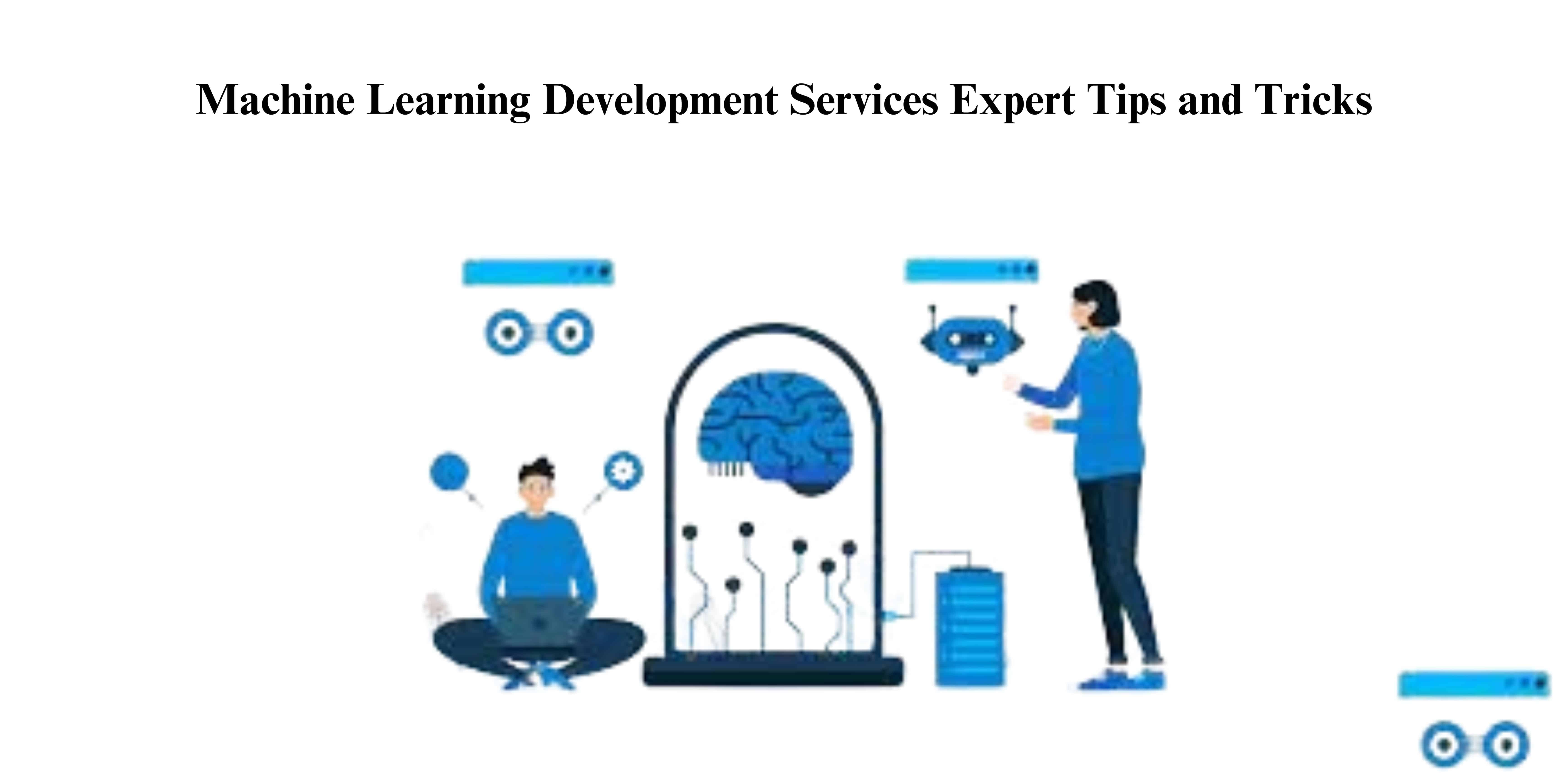Machine learning development solutions are an essential new technological frontier, revolutionizing how companies use data to provide insight and make better decisions. In this rapidly changing area, understanding the intricacies of developing machine learning solutions requires more than technical expertise. It requires a strategic combination of knowledge and creativity.
In its essence, machine learning development involves creating models and algorithms that allow systems to gain knowledge from the data and make forecasts or decisions on their own. The process is complex and begins with a robust data collection and processing process, where the data’s quality and relevancy directly affect the models’ accuracy and performance. Experts emphasize the crucial significance of data exploration and feature engineering in uncovering patterns that boost the efficiency of models.
Furthermore, choosing the appropriate frameworks and algorithms is vital. From traditional regression techniques to the most advanced deep learning frameworks, every approach has distinct advantages based on the specific problem. Experienced professionals often recommend continuous development, in which models are continuously tested and refined against actual data to ensure reliability and the ability to scale.
Successful software development services focus on transparency, interpretability, technical proficiency, and expertise. As the models become more sophisticated, describing their reasoning becomes crucial, especially in regulated industries or critical applications. Techniques like model explanation ability and bias detection can help reduce risk and build confidence in AI-driven solutions.
Additionally, staying on top of the latest industry trends and best practices is vital. Continuous Learning and exploration allow developers to leverage the latest tools and techniques, encouraging innovation and customer competitive advantage.
What is Machine Learning Development?
The process is creating machines that can learn and improve independently, thanks to being explicitly programmed.
The main goal for machine learning is design algorithms that automatically aid systems to collect data and using it to find out more. The system is expected to search for patterns among the records it gathers and make crucial decisions.
Machine learning generally involves creating systems that behave and think like humans, display human-like abilities, and even give them a brain. On the other hand, in real life, there exist machine learning systems that are capable of tasks such as :
- The process of separating spam from genuine emails, As seen in Gmail
- Correcting spelling and grammar mistakes: Autocorrect is a way of correcting spelling and grammar mistakes.
Machine learning has enabled us to witness designs that can display an uncanny human-like mentality and perform tasks such as:
- Recognition of images and objects
- The detection of fake information
- Understanding written or spoken words
- Bots on websites are human-like and interact just like humans
- Self-driven cars
Steps to Develop Machine Learning Solutions
The steps necessary to create machine learning applications.
Define Problem Scope and Goals
The first step in creating machine learning software is identifying the issue you want to address. This requires understanding the goals of your research or business, identifying the particular problem in that context, and defining the requirements for the success of the machine learning model you’ve created. If, for instance, you’re making an anti-fraud system, your aim could be to limit false positives and catch the most fraudulent transactions.
Data Collection and Preparation
Data is the vital ingredient of any machine learning endeavor. This process involves identifying pertinent data sources, gathering raw data, and preparing it for analysis. Data preparation typically consists of clearing the database (handling outliers and missing values), transforming it into an appropriate format (normalization or encoding categorical variables), and dividing it into validation, training tests, and training sets.
Exploratory Data Analysis (EDA)
EDA involves looking at and analyzing the data to gain insight into its structure patterns, relationships, and structures. Methods like statistics summaries, data visualization (histograms and scatter plots), and correlation analysis assist in understanding the distribution of data and identifying attributes that can be beneficial in modeling.
Feature Engineering
Feature engineering is an essential component of developing machine-learning models. It involves transforming the data into features that improve the model’s performance. This can include identifying relevant features, constructing new features based on understanding the appropriate domains, and then applying transformations to enhance the power of predictive models.
Model Selection and Training
The selection of the best machine-learning algorithm(s) depends on the nature of the problem (classification and regression or clustering) and the data type. The most popular algorithms are
- linear regression and decision trees,
- Support Vector Machines,
- The deep-learning models consist of Convolutional neural network (CN N) and Recurrent neural networks (RNNs).
In this phase, models are taught on the dataset used for training, using appropriate evaluation metrics to improve performance.
Model Evaluation and Validation
After training, machine learning models must be evaluated to determine their effectiveness and generalization capability. Validation techniques such as cross-validation, holdout and validation may be used to assess the validity of models and to identify any issues that are not fitting properly (where models perform very admirably with the training data, however is not as effective when it comes to data that has not been observed). Metrics like precision, accuracy recall, F1-score, and accuracy are used to evaluate the performance of models.
Hyperparameter Tuning
Adjusting the model’s hyperparameters (parameters that control the learning process) is essential for optimizing its performance. Methods like grid searches, random search, and Bayesian optimization are used to discover the optimal combination of hyperparameters to minimize errors and enhance the model’s robustness.
Deployment and Monitoring
After creating a satisfactory model, it must be put in a production environment to predict undiscovered data. The deployment process involves integrating the model into existing systems, setting up monitoring tools to monitor the model’s performance, and ensuring that it has the model’s scalability and stability.
Iterative Improvement
Machine learning development is a continuous process. Even after the models have been deployed, they should be constantly monitored and evaluated for changing information distributions and business needs. Feedback loops from stakeholders and users can help in further enhancements or training.
Documentation and Maintenance
Documenting the entire machine learning process, including the data sources’ processing steps, preprocessing processes, models, and deployment details, is crucial to ensuring transparency and consistency. Maintenance involves updating models using new data, retraining them periodically to avoid model degrading, and fixing any issues that occur in production.
Tips and Tricks for Machine Learning Development
Here are the essential suggestions and tricks to simplify the development of machine learning and to ensure the development of solid Machine Learning Systems:
Define Clear Objectives and Metrics
Before beginning to develop a model, be clear about the issue you are trying to solve and the way the success of your model will be evaluated. This is essential since it will guide the whole ML process, from the collection of data to the evaluation of models. Find key performance metrics (e.g., precision, accuracy, and recall) aligned with business objectives. For example, reducing false positives could be more critical regarding overall efficiency in a security system for fraud prevention.
Collect and Prepare Quality Data
Quality data is the foundation of successful ML projects. Ensure your data is clean, pertinent, reliable, and representative of the issue area. Use the exploratory process of analysis (EDA) to comprehend data distributions, spot outliers, and deal with missing values promptly. Apply techniques for data processing, like feature scaling, normalization, and dimensionality reduction, to enhance the efficiency and performance of your model.
Choose the Right Algorithms and Models
The choice of the right algorithm will be based on the kind of information and the particular issue that you are facing. Explore different models, ranging from classical techniques like linear regression or decision trees to more advanced methods like deep Learning and group methods. Be aware of factors like the complexity of the model, its interpretability, and the computational resources needed. The tuning of hyperparameters using techniques such as grid searches or Bayesian optimization can further improve the performance of models.
Validate and Evaluate Model Performance
Beware of overfitting by validating your model using reliable methods like cross-validation and holdout validation. Examine performance metrics for both validation and training data to measure model generalization. Techniques such as ROC curves confusion matrices, confusion matrices, and learning curves can provide more insight into models’ behavior and help identify areas that could be improved.
Focus on Feature Engineering
Using feature engineering effectively can significantly improve model performance. It transforms raw data into valuable features that can identify relevant patterns and connections. Techniques such as one-hot encryption polynomial features, one-hot encoding, and feature scaling may improve models’ interpretability and predictive accuracy. Domain knowledge plays a significant part in this, as it guides the choice and development of informative features.
Pay Attention to Model Interpretability and Explainability
In many cases, knowing why models make specific predictions is just as important as accuracy in prediction itself. Select transparent models when transparency is crucial and employ methods such as SHAP (Shapley Additive explanations) values and LIME (Local Interpretable Model-agnostic Explanations) to describe black-box models. This increases trust in the machine learning system and allows stakeholders to make an informed decision based on the model’s results.
Implement Scalable and Robust ML Pipelines
Create efficient and scalable ML pipelines that automate data processing and model training and deployment. Tools such as Apache Airflow, Kubeflow, and MLflow aid in the orchestration of pipelines, as well as version control and reproducibility. Make sure pipelines are modular and flexible to consider future updates or changes in the data volume or distribution.
Incorporate Regular Model Monitoring and Maintenance
Machine learning models decrease in time due to shifts in data distribution or external influences. Use monitoring tools to assess the model’s real-time performance and trigger retraining whenever needed. Implement robust deployment strategies such as A/B tests and gradual rollouts to limit the risk and ensure a smooth introduction into existing environments.
Staying Up-to-Date with Latest Trends
The machine learning field is evolving quickly, and new algorithms, methods, and frameworks are surfacing often. Be informed of the latest developments by reading conferences, researching papers, and participating in online forums. Explore the latest models and adopt best practices to increase the performance and effectiveness of your machine learning systems.
Foster Collaboration and Continuous Learning
Effective ML development typically requires collaboration among multidisciplinary teams comprising engineers, data scientists, domain experts, and business stakeholders. Create a culture of sharing that encourages iteration and continual Learning that draws on diverse perspectives and knowledge. Inspire feedback loops to improve models and processes incrementally.
Key Features in Machine Learning Development
Machine learning (ML) technology has revolutionized many industries through computers’ ability to understand data and make predictions or decisions. This technological breakthrough is based on various key characteristics that define its skills and applications.
Data Collection and Preprocessing
The core of any machine learning program is data. The data’s quality, quantity, and value directly affect the model’s efficiency. Data collection is the process of collecting a variety of data sets that satisfactorily cover the domain of concern. This process usually involves cleaning and preprocessing the data for missing values, outliers, and irregularities. Methods such as feature scaling, normalization, and dimensionality reduction significantly prepare data to model.
Feature Engineering
It is the process of transforming and selecting elements or variables in the data set to increase the accuracy of models. It requires domain-specific knowledge and creativity to discover relevant features that improve the predictive power. Techniques such as one-hot encryption features, feature scaling, and transformation (like polynomial or logarithmic transformations) are typical in feature engineering.
Model Selection
The choice of the best machine learning model is crucial. It is based on the type of problem (classification or regression, clustering), the amount of data available, and the level of understanding desired. The algorithms range from classic ones like linear regression or decision trees to more complex neural networks and ensemble techniques like random forests and gradient-boosting machines. Each model has strengths and limitations regarding accuracy, training time, and understanding.
Training and Evaluation
Learning a machine learning model requires making its parameters more flexible to the data. The goal is to minimize the chance of making mistakes in predictions on data that isn’t seen. Measurement metrics such as the precision, accuracy F1-score, ROC-AUC, and F1-score may be used to assess the effectiveness on the part of the model. Cross-validation methods aid in determining how the model adjusts to changing data, and helps in avoiding excessive fitting.
Hyperparameter Tuning
Hyperparameters are parameters established before the process of learning starts. They influence the process of Learning and performance. Adjusting these hyperparameters requires optimizing them to ensure the highest performance of the model. Techniques like grid search, random search, or Bayesian optimization are employed to determine the most effective hyperparameters.
Model Deployment
Implementing a machine-learning model in production requires integrating it into existing systems or applications to provide real-time predictions. This process involves consideration of reliability, scalability, and Monitoring. Technologies like containers (using Docker) and cloud services (like AWS or Azure) APIs allow seamless integration and scaling of machine learning algorithms.
Interpretability and Explainability
Knowing how machine learning models make predictions is vital to getting trust and acceptance in real-world applications. Methods such as feature importance analysis SHAP (Shapley Additive explanations) values and techniques that do not depend on models (such as LIME) can provide insight into the decisions made by models. The ability to understand AI (XAI) is an emerging field focused on creating machine learning models that are clearer and more understandable.
Continuous Learning and Maintenance
Machine learning models require constant Monitoring and updates to adjust to changes in data patterns and business requirements—methods such as online learning and model retraining aid in maintaining the accuracy of models as time passes. Monitoring the performance indicators and loops of user feedback ensures that the model is robust and efficient in production.
Ethical Considerations and Bias Mitigation
Since machine learning systems affect the decision-making process in crucial areas like healthcare, finance, and criminal justice, addressing ethical considerations and biases becomes essential. Methods like fairness-aware programming, bias detection, and mitigation strategies ensure that models don’t cause discrimination or inequity.
Collaboration and Documentation
Machine learning development usually requires multidisciplinary teams consisting of data scientists, domain experts, software engineers, and business stakeholders. Precise and efficient collaboration and thorough documentation of the processes, algorithms, and decisions are vital to ensuring transparency and consistency for ML projects.
Top Benefits in Machine Learning Development
The main benefits of investing in the machine learning development highlight its transformational potential across various fields.
Automation of Repetitive Tasks
One of the significant advantage of machine learning is its capacity to perform repetitive jobs that generally require considerable human effort. Machine learning algorithms can be trained by training to manage routine tasks like data entry, coding of documents, or even customer service queries. Automating these processes saves time, cuts operating costs, eliminates mistakes, and improves organizational workflow efficiency.
Improved Decision Making
Machine learning algorithms are skilled at processing massive quantities of data, and getting useful insights from huge amounts of data. By studying patterns in historical data, ML models can predict future outcomes or trends with the highest degree of precision. This lets businesses make fast, informed decisions using data-driven information instead of intuition. For example, financial institutions employ ML to evaluate credit risk, and retailers rely on it to predict demand and improve the amount of inventory available.
Personalization of User Experiences
In today’s digital age, personalized user experiences are the primary driver of customers’ satisfaction and loyalty. Machine learning algorithms evaluate the user’s behavior and preferences to adapt suggestions, ads, content, and other features specifically for each user. This type of personalization not only increases the user’s experience but also boosts revenue and conversions. For instance, streaming sites suggest movies based on the times users have watched them, and online stores provide product recommendations based on previous purchases.
Predictive Maintenance and Fault Detection
Machine learning plays an important function in predicting maintenance in transportation and manufacturing. By monitoring equipment performance and studying sensor data in real-time, machine-learning models can anticipate the possibility of failures before they happen. This proactive approach can help prevent expensive downtime, increase machines’ life, and enhance overall efficiency. Similarly, ML algorithms can detect system flaws or anomalies, allowing for prompt intervention to minimize risks and ensure security.
Enhanced Customer Service and Support
Chatbots that are powered by machine learning, as well as virtual assistants, have revolutionized customer service, providing immediate responses to questions or issues. AI-powered systems can comprehend natural language, understand customers’ intent, and offer pertinent information or support at all-day hours. In addressing routine questions efficiently, businesses can boost customer satisfaction while allowing human employees to concentrate on more challenging tasks requiring empathy and problem-solving abilities.
Scalability and Adaptability
ML development models are built to be scalable and adaptable to growing numbers of data and changing business requirements. If you analyze millions or thousands of data points, these models can maintain their performance without requiring significant manual intervention. Furthermore, ML models can adapt to changing data and environmental trends, ensuring an ongoing advancement in accuracy and relevance. The flexibility and scalability of ML models make machine learning a significant resource for companies looking to remain competitive in changing markets.
Fraud Detection and Cybersecurity
In healthcare, finance, and e-commerce, machine learning is critical to identifying fraudulent transactions and improving security measures. ML algorithms can quickly detect suspicious activity and alert potential threats by analyzing real-time transaction patterns, user behavior, and network activities. This proactive approach can help stop financial fraud, protect sensitive data, and safeguard businesses from malicious attacks by boosting confidence and trust among clients and other stakeholders.
Innovation and Product Development
Machine learning is a great way to boost innovation, helping companies discover new opportunities as well as develop innovative products and services. Through predictive analysis and data, companies can detect patterns in the market, identify hidden patterns, and develop solutions to meet customers’ changing needs. Requirements. From autonomous cars to personalized medical treatment, the ML-driven revolution is transforming industries and opening the way for revolutionary advancements that will drive expansion and gain competitive advantage.
What is the cost to create Machine Learning?
The cost estimate for ML development differs widely based on the project’s particulars and geographical location. But, a rough estimate to develop an ML project from its conception to deployment could vary from tens of thousands in the hundreds to a few hundred thousand dollars.
- Easy ML Projects: Basic regression or classification tasks could cost anywhere from $10,000 to $50,000.
- Projects of moderate complexity: Involving NLP, computer vision, or recommendation systems usually cost between $50,000 and $200,000.
- Complex projects: Such as deep learning models, large-scale data processing, or AI-driven apps, can surpass $200,000 and even into the thousands for enterprise-level solutions.
The influence of geography on costs is significant, as rates differ across regions like North America, Europe, and Asia. Furthermore, a shortage of qualified labor and infrastructure affects project pricing.
Factors that impact the price for Machine Learning Development
Understanding these elements is vital for developers and business owners to plan efficiently and budget for ML projects. This section will provide an overview of the most critical factors that impact the cost of machine learning development:
Problem Complexity and Scope
The magnitude and complexity of the problem to be addressed are the primary factors in the determination of ML costs of development. Simple tasks like the linear regression model or simple models for classification are not as expensive compared to more complicated tasks such as natural language processing (NLP), image recognition, or anomaly detection. Complex issues require more advanced algorithms, extensive preprocessing of data, and possibly more advanced infrastructure for hardware, all of which increase costs.
Data Quality and Quantity
Data is the heart of machine learning. Quality, quantity as well as the accessibility of data significantly determine the cost of development. Quality data that is clean, identified, labeled, and practical helps reduce the time spent processing data and increases the model’s accuracy. Acquiring and cleaning large databases can be costly, particularly in cases where specialized domain knowledge or data sources with proprietary characteristics are needed.
Algorithm Selection and Customization
Selecting the best ML algorithms specifically designed for the task at hand is essential. Off-the-shelf algorithms are often employed for routine tasks; however, customized algorithms or changes to existing ones could be required for specific requirements. Making or fine-tuning algorithmic designs requires skills and time, which can increase costs, especially when dealing with complex or highly specialized applications.
Infrastructure and Technology Stack
The choice of infrastructure and technology stack can affect the development process and cost. ML models typically require substantial computational resources, like GPUs, to train deep learning models or cloud services to enable scalable deployment. The price of these resources differs depending on the model’s usage, scalability requirements, and the cloud provider chosen. Making the most of infrastructure and using cost-effective, efficient solutions can reduce costs.
Human Resources
The right personnel is essential to success in ML development. The team typically comprises researchers, data analysts, ML technicians, domain experts, and perhaps project managers. Finding and keeping qualified professionals can be costly, particularly in a highly competitive market where demand for ML talent is more significant than supply. Training current staff members or outsourcing to agencies with specialized expertise can impact the overall cost of a project.
Model Testing and Validation
Validation and rigorous testing are crucial to ensure the accuracy of the model, its reliability, and the robustness of ML models. This process involves testing with various datasets and real-world scenarios. This requires time as well as resources. Automated testing frameworks and manual validation by experts in the domain add to the costs but are necessary to deliver the most reliable ML solution.
Regulatory Compliance and Security
Conforming to the requirements of regulatory agencies, especially in susceptible areas like finance or healthcare, creates more complexity and increases costs for ML development. Data regulations on privacy (e.g., GDPR, GDPR HIPAA) require strong security measures, techniques for data anonymization, and audit trail. Investing in secure infrastructure and adopting the best methods for handling data and model implementation are vital cost-saving considerations.
Maintenance and Upgrades
ML models aren’t static. They require constant Monitoring, maintenance, and periodic adjustments to accommodate changes in data patterns and business requirements. Managing resources through regular maintenance, bug fixes, performance optimization, and user feedback will ensure the long-term viability of ML models but increase overall cost during the project’s life.
Geographical Considerations
Costs may vary significantly by location because of labor rates, infrastructure availability, and regulatory environment differences. Remote outsourcing or using offshore teams could provide cost advantages; however, they can also pose challenges due to communication, time zone variations, and other cultural aspects that affect project efficiency and results.
Project Management and Overhead
Effective project management methods simplify development processes, control resources efficiently, and minimize risk. However, specialized project management comes with additional costs, including administrative expenses, software licenses, collaboration, and collaborative tools. Balancing these costs against the size of the team and project complexity is essential to optimizing the overall development costs.
Challenges in Machine Learning Development
Development of Machine Learning solutions is a complex activity that combines statistical analysis knowledge of programming and domain-specific expertise. Although the potential benefits are enormous, several obstacles can slow progress and hinder effectiveness.
Data Quality and Quantity
The foundation of every machine-learning model is the data. Quality and quantity of information has a direct bearing on the accuracy and reliability of a machine-learning model. The most common problems are:
- Data acquisition: Finding enough accurate data may be complex, particularly for proprietary or niche domains.
- Cleansing Data: Raw data typically is prone to inconsistent values, inconsistencies, or noise, which requires intensive processing.
- Data privacy: Ensuring compliance with laws (like GDPR) when handling sensitive data presents technical and legal challenges.
Overfitting and Underfitting
The balance between overfitting (when models perform very well on data from training but cannot do so when faced with newly acquired evidence) and underfitting (when the model cannot understand the fundamental patterns) is vital. The challenges here are:
- Model Complexity: Complex models may overfit, while simple models could underfit.
- Methods of Regularization: Utilizing regularization techniques to stop overfitting without compromising the model’s performance.
- Cross-validation: Testing the model’s performance across various datasets to prevent insufficient or excessive fitting.
Model Selection and Evaluation
Selecting the correct algorithm and evaluating its performance are essential actions. Problems can be found in:
- Algorithm selection: Different algorithms are suited to different kinds of tasks and data, which requires attention to detail.
- Evaluation metrics: Choose the appropriate metrics (accuracy, recall, precision, and so on) that meet the business’s objectives.
- Interpretable models: Ensure that models can be used for interpretation, particularly in areas that require transparency (like law and healthcare).
Scalability and Computational Resources
As the volume of data increases and the computing demands increase, Problems can be posed by:
- Hardware Constraints: Affordable hardware (GPUs, TPUs, GPUs) to train and deploy large-scale models.
- Scalability Problems: Insuring that models can manage increasing data sizes and remain effective.
- Cost Aspects: The goal is to balance computational costs by enhancing performance.
Deployment and Maintenance
The translation of a model from creation to deployment has the same set of challenges:
- Integration: seamless integration of models from ML into workflows and systems that are already in place.
- Monitoring: Monitoring continuously models effectiveness and alters it when the distribution of data changes.
- Version Control: Controlling versions of models and data to ensure traceability and consistency.
Ethical and Social Implications
The emergence of AI and ML puts ethical issues into the forefront:
- Fairness and Bias: Resolving data biases that could perpetuate societal inequalities.
- Accountability: Who is accountable for ML models that make mistakes or have unintended results?
- Regulation Compliance: adhering to ethics guidelines as well as legal structures that govern AI as well as ML.
Future Trends in Machine Learning Development
Looking ahead, we see various trends poised to determine its future direction.
Reinforcement Learning and Autonomous Systems
Learning through reinforcement (RL) is getting more attention, especially in autonomous systems. From autonomous cars to robotics, RL enables machines to learn from past experiences and make choices in complex situations. Future advances will enhance RL algorithms for real-world uncertainty and scale applications across different industries.
Federated Learning for Privacy-preserving AI
With increasing concerns about data privacy, federated Learning is emerging as a viable solution. It lets you train machine learning models on uncentralized data sources while preserving user privacy. Future trends include refining federated learning protocols to improve the efficiency of convergence models and incorporating them into finance, healthcare, and IoT applications.
Explainable AI (XAI) and Ethical AI
As AI systems are involved in decision-making processes, the need for transparency and ethical considerations increases. It is possible to explain AI (XAI), a project to create AI algorithms that are understandable to humans, thus fostering confidence and accountability. The future will be focused on creating understandable models, setting ethical guidelines, and maintaining fairness in AI applications.
Quantum Machine Learning
Combining quantum computing with machine learning will lead to significant enhancements in efficiency and computational power. Quantum machine learning studies algorithms optimized for quantum processors that allow more efficient data processing and solve complicated optimization problems. Future developments include advances in quantum technology, the development of quantum ML algorithms, and applications in the research and development of drugs, cryptography, and materials science.
AI-driven DevOps and MLOps
Integrating AI in DevOps practices, also known as AIOps, improves the efficiency of automation, predictive analytics, and infrastructure management. MLOps expands this idea to manage the machine learning lifecycle, allowing reproducibility, scaling, and collaboration within ML projects. Future trends include automation of deployment pipelines based on AI, Monitoring of models, and governance frameworks that improve the efficiency of ML development.
Edge Computing and IoT-driven ML
Edge computing enables computing capabilities closer to the data sources, reducing IoT applications’ bandwidth and latency. Machine learning on the edge allows devices to process data locally, enhancing the speed of decision-making and security. The future will focus on optimizing ML models for devices at the edge, creating efficient energy-saving algorithms, and extending applications in smart cities, healthcare, and industrial automation.
Transfer Learning and Pre-trained Models
Transfer learning speeds up model development by fine-tuning pre-trained models to particular tasks or areas. Pre-trained models such as GPT-3 and BERT have shown remarkable performance across many applications, from natural language processing to image recognition. The future is about building larger, domain-specific models, developing transfer learning techniques, and making it easier to access AI capabilities.
Generative AI and Creative Applications
Artificial intelligence algorithms like GANs (Generative Adversarial Networks) are revolutionizing the creative industry by creating realistic videos, images, and music. Future developments will focus on advances in generative models that allow for content production, AI-driven interactive design tools, and applications for VR (VR) and Augmented Reality (AR).
Conclusion
Understanding the complexity of creating machine learning-based solutions requires a combination of knowledge about technology, planning and flexibility. The process starts with understanding the issue to ensure that the business objectives are aligned with technological capabilities. Selecting the correct models and algorithms while balancing computation complexity with computational efficiency and accuracy is essential. Testing and validation through iterative steps can be crucial to improving models and ensuring their performance in real-world situations.
Furthermore, the collaborative nature of the machine learning development process can’t be overemphasized. Teams with cross-functionality, which include data experts, domain experts, and software engineers, encourage innovation through diverse perspectives and skills. Effective communication and project management processes simplify workflows, ensuring deadlines are met and expectations are over and above.
Additionally, keeping current with new developments in machine-learning tools and frameworks is crucial. Continuous Learning and upgrading enable teams to fully exploit the potential of the latest technologies while maintaining an edge in the constantly evolving world of AI and ML.
FAQs
What are the main factors to consider when selecting the best machine-developing service provider for learning?
It would be best to look for experience in the relevant fields, previous experience in comparable projects, a solid portfolio, and a team with solid engineering and data science abilities.
How can companies ensure they are successful with their machine-learning projects?
Ensure your project has clear objectives, adequate data quality and quantity, constant stakeholder involvement, and an established evaluation metric to measure successful completion.
What are the most common issues in the development of machine learning?
The challenges include issues with data quality, model interpretability, and scalability, as well as connecting to existing systems and keeping models current.
What is the role of data preparation in projects involving machine learning?
Data preparation is vital since it requires cleaning and preprocessing information to ensure that it’s suitable for training models, which directly affects the accuracy of the model and its performance.
What is the importance of the evaluation and testing of models in the development of machine learning?
Tests and evaluations of the model verify its performance using real-world data to ensure that it meets the required accuracy and reliability before deployment.
What are the most effective ways to implement machine learning models in production?
Use containerization for scaling, monitor model performance and data drift, apply revision control and ensure strong security measures.
How can companies ensure the application of machine learning in their products and services?
Conduct fairness checks to avoid bias, ensure the transparency of model decisions, obtain consent to use data, and follow ethical and legal guidelines.
What support and maintenance are required following the deployment of a machine-learning solution?
Monitoring models regularly for drift, ensuring models are updated with the latest data, addressing issues with performance, and providing training for the end-users are essential to ensuring long-term achievement.











